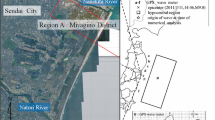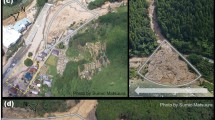Abstract
Coastal forests on the Sendai Plain reduced the force of the 2011 Great East Japan tsunami, but the tsunami also produced driftwood that increased the impact force or additional drag force due to accumulation in front of houses (damming). The advantage of reducing the tsunami force and disadvantage of increasing the force on houses after collisions of driftwood were repeatedly pointed out after the tsunami, but have never been compared quantitatively. Therefore, a driftwood model was developed to evaluate tree washout, motion of the drifting trees, and collisions with houses. Two-dimensional non-linear long wave equations were coupled with the equation for motion of driftwood, and the impact force was solved assuming the collision to be inelastic. Experiments were conducted to clarify the driftwood movement and determine the impact duration in the simulation. The ratio of the impact force of driftwood to the maximum drag force on a house was comparatively small, around 0.01–0.10. On the other hand, when driftwood piled up in front of a house, the increasing water depth caused additional fluid force. The rate of accumulation of driftwood was not large in experiments, but the magnitude of the drag force increase after accumulation was far larger than that of the impact force of collision. However, in comparison with the reduction of fluid force by the coastal forest, the fluid force due to the damming in front of a house was found to be smaller and not a main factor in the washout of houses.











Similar content being viewed by others
References
ASCE (2003) Minimum design loads for buildings and other structures, SEI/ASCE standard 7-02. American Society of Civil Engineers, Reston
CCH (2000) City and County of Honolulu building code. Department of Planning and Permitting of Honolulu Hawaii, Honolulu
Cucchi V, Meredieu C, Stokes A, Berthier S, Bert D, Najar M, Denis A, Lastennet R (2004) Root anchorage of inner and edge trees in stands of maritime pine (Pinus pinaster Ait.) growing in different podzolic soil conditions. Trees 18(4):460–466
Danielsen F, Sorensen MK, Olwig MF, Selvam V, Parish F, Burgess ND, Hiraishi T, Karunagaran VM, Rasmussen MS, Hansen LB, Quarto A, Suryadiputra N (2005) The Asian tsunami: a protective role for coastal vegetation. Science 310:643
Dengler L, Preuss J (2003) Mitigation lessons from the July 17, 1998 Papua New Guinea tsunami. Pure Appl Geophys 160:2001–2031
FEMA (2005) Coastal construction manual. FEMA 55 report, edition 3 3. Federal Emergency Management Agency, Washington, DC
FEMA (2008) Guidelines for design of structures for vertical evacuation from tsunamis. http://www.fema.gov/library/viewRecord.do?id=3463
Fenske TE, Apelt CJ, Parola AC (1995) Debris forces and impacts on highway bridges. In: Proceedings, International Association for Bridge and Structural Engineering, San Francisco, CA, pp 1017–1022
Fujii Y, Satake K (2011) Tsunami source of the off Tohoku-Pacific Earthquake on March 11, 2011 (tentative result, version 4.2 and version 4.6). (Published on the International Institute of Seismology and Earthquake Engineering website). http://iisee.kenken.go.jp/staff/fujii/OffTohokuPacific2011/tsunami_inv.html
Gotoh T, Sakai T, Hayashi M (2001) Lagrangian particle method for analysis of dam-up process by drift timbers (in Japanese). Annu J Hydraul Eng JSCE 45:919–924
Haehnel RB, Daly SF (2002) Maximum impact force of woody debris on floodplain structures. Technical report ERDC/CRRELTR-02-2. US Army Corps of Engineers, Springfield
Haehnel RB, Daly SF (2004) Maximum impact force of woody debris on floodplain structures. J Hydraul Eng 130(2):112–120
Harada K, Imamura F (2006) Effects of coastal forest on tsunami hazard mitigation—a preliminary investigation, tsunamis: case studies and resent development. In: Satake K (ed) Advances in natural and technological hazards research, Springer, pp 279–292
Hiraishi T, Harada K (2003) Greenbelt tsunami prevention in South-Pacific region. Rep Port Airpt Res Inst 42(2):23
Iimura K, Tanaka N (2012) Numerical simulation estimating the effects of tree density distribution in coastal forest on tsunami mitigation. Ocean Eng 54:223–232
Iimura K, Tanaka N, Tanimoto K, Tanaka S (2009) Analysis and evaluation of tsunami mitigation effects by coastal vegetation (in Japanese with English abstract). Annu J Coast Eng JSCE 56:366–370
Ikeno M, Tanaka Y (2003) Experimental study on impulse force of drift body and tsunami running up to land. Proc Coast Eng Jpn Soc Civ Eng 50:721–725 (in Japanese)
Ikeno M, Mori N, Tanaka Y (2001) Experimental study on tsunami force and impulsive force by a drifter under breaking bore like tsunamis. Proc Coast Eng Jpn Soc Civ Eng 48:846–850 (in Japanese)
Iwasaki T, Mano A (1979) Numerical computations of two dimensional run-up of tsunamis due to the Eulerian description. In: Proceedings of the 26th Japanese Conference on Coastal Engineering, JSCE, pp 70–74 (in Japanese)
Kathiresan K, Rajendran N (2005) Coastal mangrove forests mitigated tsunami, short note. Estuar Coast Shelf Sci 65:601–606
Mascarenhas A, Jayakumar S (2008) An environmental perspective of the post-tsunami scenario along the coast of Tamil Nadu, India: role of sand dunes and forests. J Environ Manage 89:24–34
Matsutomi H (1999) A practical formula for estimating impulsive force due to driftwoods and variation features of the impulsive force (in Japanese). Proc Jpn Soc Civ Eng 621:111–127
Matsutomi H (2009) Contribution of dynamic pressure to fluid force and probability distribution of collision force of floating bodies due to tsunami inundated flow (in Japanese with English abstract). J Jpn Soc Civ Eng Ser B2 (Coast Eng) 65(1): 836–840
Melville B, Dongol D (1992) Bridge pier scour with debris accumulation. J Hydraul Eng 118(9):1306–1310
Nadaoka K, Yagi H (1998) Shallow-water turbulence modeling and horizontal larger eddy computation of river flow. J Hydraul Eng 124(5):493–500
Nakagawa H, Takahashi T, Ikeguchi M (1992) Numerical simulation of drift wood behavior (in Japanese with English abstract). Annu Disas Prev Res Inst Kyoto Univ 35 B-2:249–266
Nandasena NAK, Tanaka N, Tanimoto K (2008) Tsunami current inundation of ground with coastal vegetation effects; an initial step towards a natural solution for tsunami amelioration. J Earthq Tsunami 2(2):157–171
Nandasena NAK, Paris R, Tanaka N (2011) Numerical assessment of boulder transport by the 2004 Indian Ocean tsunami in Lhok Nga, West Banda Aceh (Sumatra, Indonesia). Comput Geosci 37:1391–1399
Nandasena NAK, Sasaki Y, Tanaka N (2012) Modelling field observations of the 2011 Great East Japan tsunami: efficiency of artificial and natural structures on tsunami mitigation. Coast Eng 67:1–13
National Association of Australian State Road Authorities (1990) Highway bridge design specification. National Association of Australian State Road Authorities
Ray D, Nicoll BC (1998) The effect of soil water-table depth on root-plate development and stability of sitka spruce. Forestry 71(2):169–182
Robertson IN, Riggs HR, Mohamed A (2008) Experimental results of tsunami bore forces on structures. In: ASME 27th International Conference on offshore mechanics and arctic engineering (OMAE2008). Estoril, Portugal
Samarakoon MB, Tanaka N, Yagisawa J (2013) Effects of local scouring and saturation of soil due to flooding on maximum resistive bending moment for overturning Robinia pseudoacacia. Landsc Ecol Eng 9:11–25
Shuto N (1987) The effectiveness and limit of tsunami control forests. Coast Eng Jpn 30(1):143–153
Srivastava VK, Tamsir M (2012) Crank-Nicolson semi-implicit approach for numerical solutions of two-dimensional coupled nonlinear Burgers’ equations. Int J Appl Mech Eng 17(2):571–581
Suppasri A, Mas E, Koshimura S, Imai K, Harada K, Imamura F (2012) Developing tsunami fragility curves from the surveyed data of the 2011 Great East Japan tsunami in Sendai and Ishinomaki Plains. Coast Eng J 54(1): 1250008-1–1250008-16
Suzuki I, Tanaka N (2012) Numerical simulation about impulsive force on a house by tsunami-driven woody debris from coastal forest. International Conference on the Sustainable Built Environment (ICSBE-2012), Kandy, Sri Lanka
Takemura T, Tanaka N (2007) Flow structures and drag characteristics of a colony-type emergent roughness model mounted on a flat plate in uniform flow. Fluid Dyn Res 39:694–710
Tamsir M, Srivastava VK (2011) A semi-implicit finite-difference approach for two-dimensional coupled Burgers’ equations. Int J Sci Eng Res 2(6):46–49
Tanaka N (2009) Vegetation bioshields for tsunami mitigation: review of the effectiveness, limitations, construction, and sustainable management. Landsc Ecol Eng 5:71–79
Tanaka N (2012) Effectiveness and limitations of coastal forest in large tsunami: conditions of Japanese pine trees on coastal sand dunes in tsunami caused by Great East Japan Earthquake. J Jpn Soc Civ Eng Ser B1 (Hydraul Eng) 68(4): II_7–II_15
Tanaka N, Sato M (2015) Scoured depth and length of pools and ditches generated by overtopping flow from embankments during the 2011 Great East Japan Tsunami. Ocean Eng 109:72–82
Tanaka N, Suzuki I (2013) Comparison between drag force on a house behind coastal forest and impulsive force by tsunami-driven woody debris from the forest at the Great East Japan Earthquake. In: Proceedings of IAHR2013 (A11303: electronic version), Chengdu, China
Tanaka N, Yagisawa J (2009) Effects of tree characteristics and substrate condition on critical breaking moment of trees due to heavy flooding. Landsc Ecol Eng 5(1):59–70
Tanaka N, Sasaki Y, Mowjood MIM, Jinadasa KBSN (2007) Coastal vegetation structures and their functions in tsunami protection: experience of the recent Indian Ocean tsunami. Landsc Ecol Eng 3:33–45
Tanaka N, Yagisawa J, Sasaki Y, Fukuoka S (2008) Differences of tree-breaking pattern and breaking threshold moment by flood with respect to the substrate condition (in Japanese with English abstract). Annu J Hydraul Eng 52:649–654
Tanaka N, Nandasena NAK, Jinadasa KBSN, Sasaki Y, Tanimoto K, Mowjood MIM (2009) Developing effective vegetation bioshield for tsunami protection. J Civ Environ Eng Syst 26:163–180
Tanaka N, Samarakoon MB, Yagisawa J (2012) Effects of root architecture, physical tree characteristics and soil shear strength on maximum resistive bending moment for overturning Salix babylonica and Juglans ailanthifolia. Landsc Ecol Eng 8:69–79
Tanaka N, Yagisawa J, Yasuda S (2013) Breaking pattern and critical breaking condition of Japanese pine trees on coastal sand dunes in huge tsunami caused by Great East Japan Earthquake. Nat Hazards 65:423–442
Tanaka N, Yasuda S, Iimura K, Yagisawa J (2014) Combined effects of coastal forest and sea embankment on reducing the washout region of houses in the Great East Japan tsunami. J Hydro-Environ Res 8:270–280
Tanaka N, Niwata Y, Sato H, Torita H, Noguchi H (2015) High-precision tsunami simulation method considering the difference in breaking and overturning phenomenon by stand structure of coastal tress applicable to coastal forest management (in Japanese with English abstract). J Jpn Soc Civ Eng Ser B2 (Coast Eng) 71(2): I_307–I_312
Thuy NB, Tanimoto K, Tanaka N, Harada K, Iimura K (2009) Effect of open gap in coastal forest on tsunami run-up—investigations by experiment and numerical simulation. Ocean Eng 36:1258–1269
Thuy NB, Tanaka N, Tanimoto K (2012) Tsunami mitigation by coastal vegetation considering the effect of tree breaking. J Coast Conserv 16(1):111–121
Wubs FW, de Goede ED (1992) An explicit-implicit method for a class of time-dependent partial differential equations. Appl Numer Math 9(2):157–181
Yeh H, Robertson I, Preuss J (2005) Development of design guidelines for structures that serve as tsunami vertical evacuation sites. Division of Geology and Earth Resources, Washington State Department of Natural Resources
Yeh H, Barbosa AR, Ko H, Cawley JG (2014) Tsunami loadings on structures: review and analysis. Coast Eng Proc 1(34), currents-4
Acknowledgements
This study was funded by a Japan Society for the Promotion of Science Grant-in-Aid for Scientific Research (No. 15H02987).
Author information
Authors and Affiliations
Corresponding author
Rights and permissions
About this article
Cite this article
Tanaka, N., Ogino, K. Comparison of reduction of tsunami fluid force and additional force due to impact and accumulation after collision of tsunami-produced driftwood from a coastal forest with houses during the Great East Japan tsunami. Landscape Ecol Eng 13, 287–304 (2017). https://doi.org/10.1007/s11355-016-0321-7
Received:
Revised:
Accepted:
Published:
Issue Date:
DOI: https://doi.org/10.1007/s11355-016-0321-7




